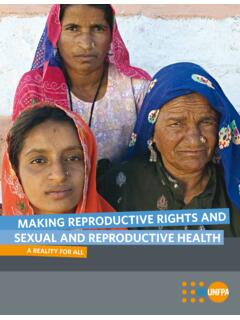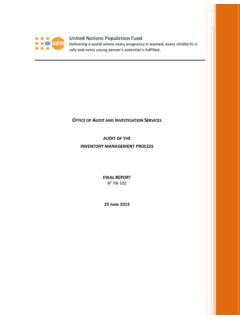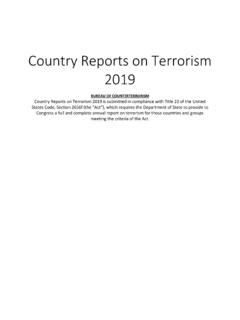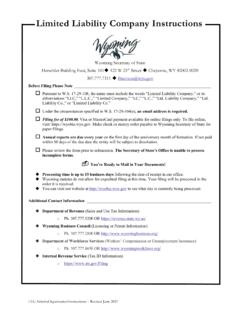Transcription of 10 CASE STUDIES - UNFPA
1 10 CASE STUDIESPROGRAMMING TO ADDRESSVIOLENCEAGAINSTWOMEN10 CASE STUDIES iCONTENTSA cknowledgementsiiForewordiiiIntroduction ivMAURITANIA:Midwives Call Attention to the Problem of Rape, and Imams Encourage Justice for its Victims1 ROMANIA: Tackling Domestic violence From Many Angles11 SIERRA LEONE: Getting at the Roots of Survival Sex21 MOROCCO: Pulling Together to Protect Women s Rights31 COLOMBIA: Claiming the Right to Life and Health in a Region of Death39 KENYA: Creating a Safe Haven, and a Better Future, for Maasai Girls Escaping Violence49 TURKEY: Celebrities Kick Into Action to Curb violence Against Women57 MEXICO: Addressing Family and Sexual violence Through Public Policy65 BANGLADESH: Community Pressure Groups Challenge Age-old Views on violence Against Women75 GHANA: Liberating Slaves and Changing Minds, Starting at the Grass Roots8512345678910 ACKNOWLEDGEMENTSThis review was produced by a team led by Ms.
2 Maysoon Melek, Culture and GenderAdviser (until 2005) in UNFPA s Technical Support Division. The team included Ms. Anne-Birgitte Albrectsen and Ms. Meltem Agduk (Turkey), Ms. Nelia Bojorquez(Mexico), Ms. Adriana Cordoba (Colombia), Ms. Boutheina Gribaa (Morocco),Professor (Mr.) Mahmuda Islam (Bangladesh), Ms. Lois Jensen (Romania), Ms. Rehema Kajungu (Mauritania and Sierra Leone), Ms. Jean Njeri Kamau (Kenya), and Professor (Ms.) Takyiwaa Manuh and Dr. (Ms.) Akosua Darkwah (Ghana).Special thanks are owed to UNFPA staff in Country Offices in Bangladesh, Colombia,Ghana, Kenya, Mauritania, Mexico, Morocco, Romania, Sierra Leone and Turkey, whodemonstrated their commitment to ending violence against women through theirenthusiasm and support in the preparation of the case STUDIES .
3 Ms. Nan Oo Kyi, in the Culture, Gender and Human Rights Branch, coordinated thework of the consultants and followed up on the production Lois Jensen edited the case review documents UNFPA s experience in the field in supporting projects that address manyforms of violence against women, with the aim of disseminating lessons that can be used to confront the problem on a wider scale. It is intended primarily for development practitioners andothers seeking to change attitudes and practices that have been passed on through the cycle of violence is a necessary and urgent task, if the realization of women s humanrights is to become a reality in millions of women, a visit to a health clinic may be the only opportunity they have to get theservices and support they need to begin to heal and escape further violence and abuse.
4 UNFPA works to ensure that addressing violence against women and girls is an integral part of sexual andreproductive health programmes. Together with our partners, we are working to bring national lawsinto compliance with international standards; training and sensitizing justice officials, the police, themedia, armed forces and United Nations peacekeepers; reaching out to men; combating harmfulpractices such as female genital mutilation/cutting and child marriage; and promoting gender growing visibility and awareness of violence against women and the suffering it causes among women, their families and in society at large has encouraged governments, civil societyorganizations and others to establish mechanisms and programmes to address the issue withpromising results.
5 Nevertheless, violence against women remains one of the most serious socialproblems of our time, cutting across racial, ethnic and class review is part of a series of explorations that UNFPA has undertaken over the last several yearsto look at the cultural dimensions of gender equality and reproductive health and rights. Violenceagainst women is a multidimensional problem that requires a multidimensional response. Adding to the complexity is the fact that every culture has its own set of attitudes and reactions to it, whichmust be thoroughly understood by anyone attempting to tackle the problem in an effective and sustainable would like to thank Maysoon Melek for leading this research, our country offices in Bangladesh,Colombia, Ghana, Kenya, Mauritania, Mexico, Morocco, Romania, Sierra Leone and Turkey for theirinsights and inputs, and the national and international consultants who worked diligently to makethis review possible.
6 I also wish to thank the Swiss Agency for Development and Cooperation, whichfinanced this endeavour, and which recognized early on the importance of adding to our knowledgein this critical area of Ahmed ObaidExecutive Director, UNFPA iiiIn the last four decades, the culture of silence that has surrounded all forms of violence againstwomen has begun to erode. Women activists, civil society groups, international organizations,governments, artists and the media have joined forcesto move this sociocultural phenomenon from a privatespace, in which it is often cloaked in shame, into thepublic sphere. With this exposure comes the possibilityto explore its impact on women, the family, communi-ties and society at large, and to take action to addressthis gross violation of women s human rights.
7 Nevertheless, violence against women2 remains perva-sive and severe the world over. It imperils the health and violates the rights of millions of women and girls of every race, religion, ethnic group and social data indicate that between 10 and 50 per centof women have been physically abused by an systematic use of rape as a weapon of warand ethnic domination has become increasingly wide-spread in conflict situations. Forced prostitution, sextourism, and trafficking in women and girls appear to be on the rise. And many traditional practices harmful to women and girls persist, causing psychological dam-age, physical injury and death. According to World Bankestimates, violence against women kills and incapaci-tates as many women of reproductive age as 1979, the UN General Assembly adopted the Conven-tion on the Elimination of All Forms of Discriminationagainst Women (CEDAW).
8 The Convention defines discrimination against women as any distinction, exclu-sion or restriction made on the basis of sex which has theeffect or purpose of impairing or nullifying the recogni-tion, enjoyment or exercise by women, irrespective oftheir marital status, on a basis of equality of men andwomen, of human rights and fundamental freedoms inthe political, economic, social, cultural, civil or any otherfield. Countries that have ratified or acceded to theConvention are legally bound to put its provisions intopractice. They are also committed to submit nationalreports, at least every four years, on measures they havetaken to comply with their treaty obligations. TheConvention entered into force in September 1981 and, asof August 2006, 184 countries over 90 percent of themembers of the United Nations were party to is the only human rights treaty that affirms the reproductive rights of women and targets cultureand tradition as influential forces shaping gender rolesand family relations.
9 States that have accepted theConvention have committed themselves to undertakemeasures to end all forms of discrimination againstwomen, including: Incorporating the principle of equality of men andwomen in their legal systems and ensuring that alldiscriminatory laws are abolished. Establishing tribunals and other public institutions to ensure the effective protection of women against women must be addressed on multiple levels and in multiple sectors of society simultaneously, taking direction from local people on how women s rights may be promoted in a given context. Executive summary of the Report of the Special Rapporteur on violence against Women,16 January 2003ivINTRODUCTION1 United Nations document A note on terminology: We are using the term violence against women rather than gender-based violence since this study is looking only at violenceagainst women and girls.
10 Gender-based violence also encompasses violence directed towards men and boys by virtue of their gender for instance, themassacre of some 8,000 Muslim men and boys in Srebrenica in Differences in the ways in which violence is defined and measured in various STUDIES account for at least some of this variation. That said, violence againstwomen is likely to be more pervasive than statistics would suggest, given variations among cultures as to what constitutes such violence , the stigmaattached to victims, which could make them less likely to report abuse, the ways in which survey questions are asked and by whom, and the setting forinterviews (privacy being a particularly important factor).















